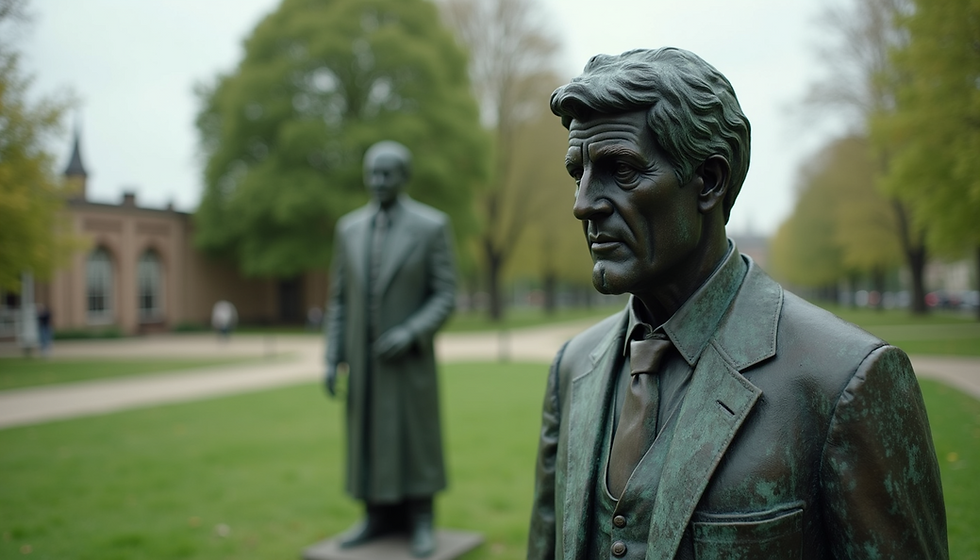Creating Contemporary Figurative Sculptures: Techniques Revealed
- Teresa Wells

- Oct 1
- 3 min read
Sculpture demands precision. Materials matter. Tools shape vision. I focus on clarity. I work with bronze, clay, and mixed media. Each piece starts with a concept. I sketch. I model. I cast. The process is methodical. The goal is to capture form and emotion. I use modern sculpture techniques to bring ideas to life.
Modern Sculpture Techniques for Precision and Impact
I begin with armature construction. Wire or metal rods form the skeleton. This supports the clay or wax. I build volume gradually. I add details last. Tools include loop tools, spatulas, dental tools and brushes. I add found objects.
Mold making is another step. Silicone rubber molds capture detail. Plaster or fiberglass mother molds locked onto keys added to the silicone for support. These molds can cast wax or resin copies. This allows multiples or corrections enabling a limited edition.
Casting is crucial. Lost-wax casting is standard. I create a wax model. I encase it in a ceramic shell. I melt the wax out. I pour molten bronze into the cavity. After cooling, I break the shell. I chase the bronze. I remove imperfections. I patinate the surface.
Welding joins bronze parts. MIG welding is used. grinding seams smooth re adding texture and the makers mark I apply chemicals for color effects. This is the patina which is protected from the elements by a final wax coating.
What are Figurative Sculptures?
Figurative sculptures represent the human form or animals. They capture anatomy, posture, and expression. I study anatomy extensively. I observe muscle structure and bone landmarks. I translate these into three dimensions.
Figurative work demands balance. Weight distribution affects stability. I test models on bases. I adjust limbs and torso angles. I aim for natural poses.
Expression is key. I sculpt faces with minimal lines. I focus on eyes, mouth, and brow. These convey mood.
Materials and Tools I Use
Bronze is my primary medium. It offers durability and detail. I also use clay for initial models. Oil-based clay holds shape well. I prefer water-based clay for quick adjustments.
Wax is essential for casting. It captures fine detail. Recycled wax blocks adding fresh wax is used melted and maintained to 100 degree temperature.
Tools vary by stage. Early modeling uses wooden and metal tools. Later stages require files, rasps, and sandpaper.
Power tools utilised for welding and grinding. Safety gear is mandatory.
The Role of Scale and Space in Sculpture
Scale affects perception. Small sculptures invite close inspection. Large works dominate space. I plan scale based on location and purpose.
Public commissions require durability. I consider weather and vandalism. I use thicker bronze sections. I reinforce internal structures.
Space influences composition. I design sculptures to interact with surroundings. I consider sightlines and lighting.
Bases and plinths anchor sculptures but i design the base to compliment and accentuate the sculpture, similar to Brancussi. I select materials that complement bronze. Stone, wood, or metal bases are common.
Finishing Techniques and Presentation
Finishing defines final appearance. bronze is chased to refine details. and remove casting marks.
Patination adds color and depth. chemicals are applied with heat. Reaction time is controlled for desired hues.
Wax coatings protect surfaces. Buffed with a lint free cloth for shine.
Installation requires planning. I coordinate with architects and landscapers. I ensure secure mounting.
Working with Clients and Public Institutions
I tailor sculptures to client needs. I discuss themes, scale, and budget. I provide sketches and maquettes.
For public projects, I comply with regulations. I consider accessibility and safety.
I manage timelines strictly. I communicate progress regularly.
Contracts specify rights and responsibilities. I ensure clarity on reproduction and display.
Expanding Artistic Vision Through Commissions
Each commission challenges me. I explore new forms and techniques. I integrate feedback and site conditions.
I document processes for future reference. I build a portfolio showcasing diversity.
I aim to be the go-to artist for bespoke bronze figurative sculptures. I seek projects across the UK and beyond.
I maintain a unique artistic vision. I blend tradition with innovation.
Explore more about contemporary figurative sculptures and my approach.
Final Thoughts on Crafting Modern Figurative Art
Sculpture is a blend of craft and fine art. Mastery of modern sculpture techniques is essential. Attention to detail and material knowledge make the difference.
I commit to quality and originality. I welcome challenges and new commissions.
The journey from concept to finished sculpture is complex. It demands patience and skill. The result is a timeless work of art.





Comments